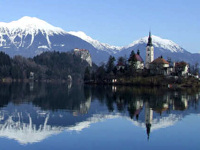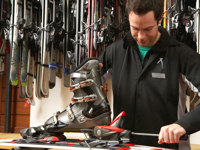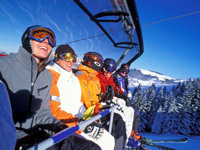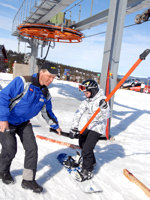Insider’s guide: Working in ski resorts
If you’re a snow sports fanatic or are simply looking for a job to tide you over the winter months, why not consider working in a ski resort? Molly Savard looks into the ins and outs of getting a job in the mountains.
Despite snow sports enthusiasts already gearing up for the slopes of Europe and North America, it’s not too late to apply for jobs this season. Some resorts continue to host job fairs and accept applications throughout November, while replacements are also regularly sought.
So follow our guide to working in ski resorts to learn how to prepare for the hiring and application process and to make the most of the coveted ‘ski bum’ way of life once you’ve got the job.
How to apply
 Stunning scenery and plentiful playtime make the work worthwhile
Stunning scenery and plentiful playtime make the work worthwhileCreative Commons / mirci
For a first-timer, getting a job in a ski resort can be a competitive affair, but don’t be intimidated by the process – the rewards of staggering scenery, a stellar social life, and guaranteed playtime are worth the effort.
Start your search by checking out job placement websites. Tour operators and resorts advertise jobs on sites such as Natives, where applicants can look for specific roles, submit their CVs, and sign up for notification emails. Season Workers also lists detailed postings and allows applicants to apply directly through the site.
If the whole process is far too overwhelming, try a company such as The Working Holiday Club. This organisation helps with visas and money transfers and sets up job placements and accommodation with its partner resorts. So all you have to do is turn up – provided you pass the interview!
While the idea of arriving at a resort and finding a job straight away may seem easy, in reality it can be hard going. Applicants will have more success finding positions through placement services. As Joe Burek, a former chairlift operator, says: “It’s tough arriving in a ski town with no job.”
Applicants can also attend resort job fairs, which provide a chance to speak to employers across a range of sectors, to gather the relevant information, and to apply on the spot.
Insider’s Tip: The Natives website is packed with advice on accommodation, getting to the resort and accounts from previous ski resort employees.
When to apply
 Apply early for the best chance of a job
Apply early for the best chance of a jobThinkstick / Digital Vision
Most international recruiting happens in the summer, with many jobs filled by November. Start attending fairs, which are usually hosted by resorts in early autumn, and you should submit your CV even earlier, in May.
You may either be hired there and then or within weeks of attending a job fair, while hopefuls that have submitted their applications through websites may have to wait up to a few months to hear back from potential employers.
While many positions are filled by the autumn, there are still plenty of options for latecomers, according to Jim Duncombe of Natives.
“The best time to apply is anytime after the end of May,” he says. “That’s when the recruitment season starts kicking off.
“But there are still quite a lot of jobs available now. Companies will recruit all the way up to the end of November - now’s the time when resorts are particularly looking for skilled candidates. Quite a few people also decide to leave or break something during the season and need to be replaced by new recruits.”
Resorts in the Southern Hemisphere, tend to leave their recruitment to the last minute, Duncombe says, meaning successful applicants in May will be working on the slopes by June.
“Resorts in the Southern Hemisphere tend to recruit just before they open,” Duncombe says. “They don’t have a massive recruitment policy because they’re a lot smaller.”
Insider’s tip: Check job websites regularly as roles can become available throughout the season and sign up for job alerts with recruiters.
Which resort?
 Do you prefer working in a chalet or on the slopes?
Do you prefer working in a chalet or on the slopes?Creative Commons / Jess & Peter
Consider the type of experience you’d like to have. Does a tiny, tucked-away chalet seem delightful or dull? Is fresh powder more important than après-ski partying? Major resorts such as Whistler Blackcomb and Chamonix can provide a compromise for those who want a vibrant, well-rounded season, while smaller resorts offer a more focused experience.
“We have a variety of roles that offer a bit of everything,” says Karen Bauckham, recruiting manager at Whistler Blackcomb.
“You may be working on the mountain outdoors or in one of our chalets or restaurants. We have many jobs where you get around on your skis and really maximise your time on the mountain,” Bauckham adds.
Apply to several resorts to improve your chances. If you don’t hear back from your dream resort, keep an open mind; any experience will be of benefit to future employers.
Bigger or more popular resorts do not necessarily promise a spectacular season, and in fact may mean greater competition for jobs, increased living expenses and a stressful work environment. Jobs in France are prized for their access to great skiing, but are more elusive, while resorts in Austria deliver intimacy and dynamic nightlife.
Some resorts reserve jobs for current employees or returning applicants, so once you’re in, your chances of landing a job may improve.
Insider’s Tip: Ifyouski.com offers case studies on various roles, which will give you an idea of exactly which job is best for you.
Required qualifications
 Working as an instructor requires previous experience
Working as an instructor requires previous experienceCreative Commons / Skistar Trysil
You needn’t have extensive experience in hospitality or be a top-level skier but, as always, you have to meet the employer’s needs. For example, English-only speakers may have to rule out some resorts such as France’s La Clusaz that expect employees to speak the language, but these resorts and ski schools often hire locally anyway. Many resorts don’t require a second language, or even ski experience, since there are a number of jobs that will give you time to relax on the mountain or brush up on your snow sports skills.
“Customer service is the big one,” says Burek, who has worked in Whistler, Samoëns and Copper Mountain amongst other resorts. “Any kind of travel experience can also be useful. Good people skills and versatility in the work environment will be needed.”
If your goal is to instruct others, however, you need at least some experience and must undergo introduction training, says Manuela Munsch of the Wengen Ski and Snowboard School in Switzerland.
Most companies provide training during the first few days after arrival. Be aware that every country has its own demands for ski instructors. Some are quite rigorous, with employees working as trainees while taking courses to achieve the next level of qualification.
Insider’s Tip: “We look for people that share our love of the outdoors and create positive memories for people,” says Bauckham. “We look and hire based on attitude and will train people for the skills needed in most of our seasonal jobs.”
Where to stay
 Living and working with fellow 'ski bums' can be rewarding
Living and working with fellow 'ski bums' can be rewardingSkiWelt Wilder Kaiser - Brixental / Albin Niederstrasser
Accommodation varies between resorts, with some jobs offering places to stay, while others leave employees to find their own lodging. Housing can be expensive, unless shared with roommates, or basic if provided by the resort.
Manager of the Snow Fun ski school in Val d’Isère, Tchenko, explains how instructors at French ski schools might find themselves responsible for their living space, but they’ll make more money than those working in Australia or North American, where resorts generally provide accommodation, but deduct expenses for food and drink, leaving workers with less cash.
But tour operators and resorts will often cover housing and food expenses or offer apartment-style living at reduced rates.
“We help the new instructors with accommodation,” says Munsch. “But of course the flats/rooms are limited, so it’s always great if they already have a place to stay.”
Insider’s Tip: No matter what your accommodation, living with your fellow 'ski bums' is often one of the most memorable parts of the experience.
What’s it like?
 Be prepared for hard work as a lift operator
Be prepared for hard work as a lift operatorCreative Commons / Skistar Trysil
You probably applied for the job for reasons other than the role itself, but don’t forget why you’re there. Working weeks promise packed days, little sleep and minimal wages, and may be filled with grouchy guests, difficult children, hard labour or hours of preparing elaborate meals.
But if working behind a counter or in a chalet rather than on the slopes seems a letdown, ask your colleagues how they feel after eight hours in the cold working the chairlifts.
“As a ‘lifty’ you will be assisting people on and off chairlifts and keeping the ramps at either end in good condition. Using chairlifts can be tricky, particularly for beginners, so it’s your job to make it as easy as possible,” says Burek.
But the perks often outweigh the hard work. “Lift operations is a popular job in North America for foreigners and a great way to meet lots of people and ensure maximum time on the snow,” Burek, who has also worked as a barman, adds.
Other benefits include free or subsidised ski and lift passes and discounts in shops and restaurants. And, while resort workers wouldn’t deny the appeal of the obvious perks, most return primarily for the unique lifestyle that develops when working with other snow-lovers from all over the world.
Burek has worked five seasons in four different resorts and plans to stay a ski bum for as long he can. “You will discover a new way of life,” he says, “one that is hard to let go of”.
Insider’s Tip: Check the World Travel Guide ski hub for more than 100 resort guides to help you find your perfect resort.
Do you have any Feedback about this page?
© 2025 Columbus Travel Media Ltd. All rights reserved. No part of this site may be reproduced without our written permission, click here for information on Columbus Content Solutions.









 You know where
You know where